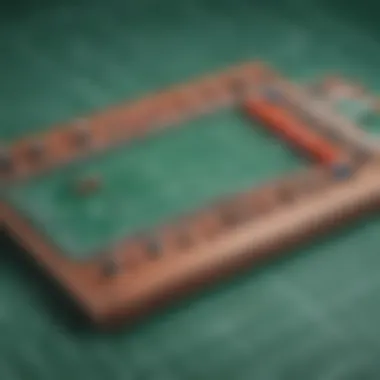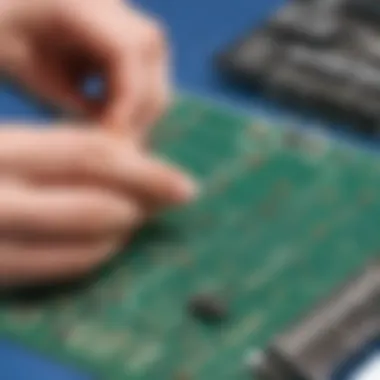Unraveling Electronic Circuits: A Beginner's Comprehensive Handbook


Science Fun Facts
Electronic circuits may seem complex, but they form the backbone of modern technology. Fun fact: The development of the first electronic circuit paved the way for the digital revolution that we are a part of today. Understanding these circuits can unlock a world of innovation and creativity for beginners stepping into the realm of electronics.
Discover the Wonders of Science
As you begin your journey into electronic circuits, you will delve into various scientific concepts. Explore how electricity flows through different components, like resistors, capacitors, and transistors. Through interactive learning tools and real-life applications, you will see how these concepts come to life in everyday devices, sparking curiosity and knowledge.
Science Quiz Time
Challenge yourself with interactive quizzes designed to test your understanding of electronic circuits. Delve into multiple-choice questions that unravel the mysteries of circuit design and functionality. Engage with brain teasers and puzzles that enhance your problem-solving skills while diving deeper into the gamification of learning about circuits.
Science Experiment Showcase
Embark on a journey of discovery through fun and engaging experiments centered around electronic circuits. Follow step-by-step instructions to build simple circuits using common materials like wires, batteries, and LEDs. Prioritize safety with handy tips and precautions, ensuring a secure and exciting exploration into the world of electronics.
Introduction to Electronic Circuits
Electronic circuits form the backbone of modern technology, allowing us to power devices, transmit information, and create innovative solutions. In this comprehensive guide, we will unravel the intricacies of electronic circuits, providing a solid foundation for beginners to explore this fascinating field. Understanding the fundamentals of electronic circuits is crucial for anyone seeking to design and construct electronic systems. By grasping the basics, individuals can unlock a world of possibilities and creativity within the realm of electronics.
Understanding the Fundamentals
Voltage, Current, and Resistance
Voltage, current, and resistance are the fundamental building blocks of electronic circuits, shaping the flow of electricity within a circuit. Voltage represents the electrical pressure driving current flow, while current is the movement of electric charges. Resistance, measured in ohms, impedes the flow of current in a circuit, determining the circuit's behavior and functionality. Mastering these concepts is essential for manipulating and controlling electronic circuits.
Series and Parallel Circuits
Series and parallel circuits are two fundamental configurations in electronic circuit design. In a series circuit, components are connected end to end, ensuring that the same current flows through each element. Parallel circuits, on the other hand, feature components connected in branches, allowing for different currents to flow through each path. Understanding the differences between series and parallel circuits is crucial for designing complex circuits and analyzing their behavior.
Essential Components
Resistors
Resistors are critical components that regulate the flow of current in a circuit, limiting the amount of electricity passing through. They are indispensable for controlling voltage levels, dividing voltage, and protecting sensitive components from excessive current. With diverse resistance values and power ratings, resistors play a vital role in customizing electronic circuit behavior.
Capacitors
Capacitors store and release electrical energy, performing vital functions such as smoothing voltage fluctuations, filtering noise, and timing circuit operations. These versatile components come in various types, including electrolytic, ceramic, and tantalum capacitors, each serving distinct purposes in circuit design. Understanding capacitors is key to optimizing circuit performance and stability.
Inductors
Inductors store energy in a magnetic field when current flows through them, resisting changes in current and smoothing voltage variations. These passive components are indispensable in applications requiring energy storage, electromagnetic interference suppression, and signal filtering. By mastering the characteristics of inductors, circuit designers can enhance the efficiency and reliability of electronic systems.


Diodes
Diodes are semiconductor devices that control the direction of current flow in a circuit, allowing current to pass in only one direction. They are essential for rectifying alternating current to direct current, protecting circuits from voltage spikes, and generating radio frequency signals. With various types such as signal diodes, zener diodes, and light-emitting diodes, understanding diodes is crucial for effective circuit design and performance.
Tools and Equipment
Multimeter
A multimeter is a versatile instrument used for measuring voltage, current, and resistance in electronic circuits. With various functions such as continuity testing, diode testing, and capacitance measurement, multimeters offer invaluable insights into circuit behavior and component functionality. Utilizing a multimeter enhances diagnostic capabilities and facilitates efficient circuit testing and troubleshooting.
Breadboard
A breadboard is a prototyping tool that allows circuit designers to create temporary circuits without soldering. It features interconnected grids for easy component placement and circuit experimentation, enabling quick iterations and modifications. Breadboards are essential for rapid prototyping, educational purposes, and testing circuit design ideas before final implementation.
Power Supply
A power supply provides the necessary electrical energy to components within a circuit, ensuring proper functionality and operational performance. With adjustable voltage and current settings, power supplies cater to diverse circuit requirements and power specifications. Choosing the right power supply is critical for powering circuits safely and effectively, preventing damage to components and ensuring reliable circuit operation.
Basic Circuit Design
Basic circuit design is a crucial aspect in the realm of electronic circuits for beginners. It serves as the foundation for constructing functional circuits by integrating essential components and following schematic diagrams. Understanding basic circuit design entails grasping the principles of voltage, current, and resistance to create circuits that operate effectively. Beginners must focus on comprehending Ohm's Law, which establishes the relationship between voltage, current, and resistance, guiding the design process. Prototyping circuits through techniques like using breadboards allows for practical experimentation and validation of circuit functionality, making basic circuit design a requisite skill for beginners venturing into electronics.
Schematic Diagrams
Symbols and Notations
Symbols and notations play a pivotal role in schematic diagrams, representing different components and connections within a circuit. These graphical representations simplify circuit design by providing a visual guide for assembling components and understanding circuit functionality. The utilization of standardized symbols enhances communication in the electronics domain, enabling engineers and hobbyists to interpret circuit diagrams universally. Despite the simplicity of symbols, they convey intricate details about component behavior and circuit operation, streamlining the design process. Embracing symbols and notations in schematic diagrams facilitates accurate visualization and implementation of electronic circuits, fostering efficient prototyping and troubleshooting.
Understanding Ohm's Law
Relationship between Voltage, Current, and Resistance
Ohm's Law elucidates the fundamental relationship between voltage, current, and resistance in electronic circuits. This principle states that the current flowing through a conductor is directly proportional to the voltage applied across it, while inversely proportional to the resistance encountered. Understanding Ohm's Law enables beginners to calculate and predict circuit behavior, ensuring proper component selection and circuit functionality. By comprehending this relationship, individuals can design circuits more effectively, optimizing performance and mitigating potential issues. Ohm's Law serves as a cornerstone in basic circuit design, guiding the manipulation of voltage, current, and resistance to achieve desired circuit outcomes with precision and accuracy.
Prototyping Circuits
Using Breadboards
Breadboards are essential tools for prototyping circuits, allowing beginners to experiment with component placement and connections in a non-permanent manner. The key advantage of using breadboards lies in their reusability and flexibility, enabling rapid testing and modifications without soldering. Beginners can easily rearrange components on a breadboard to assess various circuit configurations and troubleshoot potential issues, fostering a hands-on learning experience. While breadboards offer versatility and convenience in prototyping, they may introduce limitations in high-frequency applications due to signal degradation and parasitic effects.
Prototyping Techniques
Prototyping techniques encompass various methods for validating circuit designs before final implementation. From simulation software to physical mock-ups, prototyping techniques enable beginners to evaluate circuit functionality and performance efficiently. Each technique has its advantages and limitations, influencing the prototyping approach based on complexity and accuracy requirements. By incorporating diverse prototyping techniques, individuals can refine their circuit designs iteratively, ensuring optimal performance and functionality in electronic applications.
Types of Circuits


In this enlightening segment of the guide, we delve into the pivotal realm of types of circuits, laying the foundation for a profound understanding of electronic systems. Understanding the distinction between analog, digital, and mixed-signal circuits is essential for any budding electronics enthusiast. Analog circuits, such as amplifiers and filters, deal with continuous electrical signals, offering functions like signal amplification and noise filtering. Digital circuits, on the other hand, operate with discrete signals, employing logic gates and flip-flops for data processing and storage. Mixed-signal circuits bridge the analog-digital gap, with AD and DA converters facilitating seamless signal conversion.
Analog Circuits
Amplifiers
Amplifiers, the unsung heroes of analog circuits, play a crucial role in signal processing by increasing signal strength without altering its essential characteristics. Their high input impedance and low output impedance make them ideal for diverse applications, from audio systems to medical devices. The ability to boost weak signals for better transmission efficiency is a key advantage of amplifiers, although issues like noise interference can pose challenges.
Filters
Filters in analog circuits are like gatekeepers, selectively permitting or blocking certain frequencies to enhance signal quality. Whether it's removing noise from audio recordings or refining radio signals, filters are indispensable components. Their unique feature lies in customizable cutoff frequencies, allowing precise signal conditioning. However, some filters may introduce phase distortion or signal attenuation, necessitating careful design considerations.
Digital Circuits
Logic Gates
At the heart of digital circuits, logic gates are the building blocks of computational logic, enabling tasks like AND, OR, and NOT operations. Their binary nature and Boolean algebra principles make them fundamental in designing processors, memory units, and communication systems. The inherent simplicity and reliability of logic gates make them a popular choice for digital circuitry. Yet, complex functions may require cascading multiple gates, potentially increasing circuit complexity.
Flip-Flops
Flip-flops, the memory cells of digital circuits, store binary information through state changes triggered by clock signals. From maintaining data integrity in registers to facilitating sequential circuit operation, flip-flops are essential components in modern electronics. Their ability to latch and store data effectively simplifies sequential logic design. However, issues like metastability can arise in asynchronous circuits, requiring careful synchronization techniques.
Mixed-Signal Circuits
A and A Converters
AD and DA converters act as bilingual interpreters in mixed-signal circuits, converting analog signals to digital and vice versa. These converters enable seamless integration of analog and digital systems, facilitating tasks like audio processing and sensor interfacing. The precision of AD converters and fidelity of DA converters ensure accurate signal conversion. Nonetheless, factors like sampling rate limitations and resolution affect the overall performance of these converters.
Troubleshooting and Maintenance
In this section of the comprehensive guide on Electronic Circuits for Beginners, we delve deep into the crucial aspects of troubleshooting and maintenance. Understanding the importance of troubleshooting and maintaining electronic circuits is fundamental for ensuring their proper functionality and longevity. By being adept at identifying and rectifying issues, electronics enthusiasts can enhance their circuit design skills and prevent costly damage to components.
Common Issues
Short Circuits
Short circuits are a common problem in electronic circuits that occur when current flows along an unintended path due to a low-resistance connection. Within the context of this article, exploring short circuits is pivotal as it sheds light on the impact of improper circuit design and component placement. The key characteristic of a short circuit is its ability to disrupt the intended flow of current, potentially damaging components and causing malfunctions. Understanding short circuits is crucial for beginners as it emphasizes the significance of precise wiring and insulation to avoid unintentional connections.
Open Circuits
Conversely, open circuits refer to a situation where there is an interruption in the flow of current due to a broken connection. Discussing open circuits within this guide is essential to underscore the importance of continuity in circuit design. The main characteristic of open circuits is the lack of current flow, leading to non-functioning circuits. For beginners, grasping the concept of open circuits highlights the necessity of securely connecting components to ensure seamless operation and troubleshoot effectively.
Testing Circuits


Using Multimeter
The utilization of a multimeter in testing circuits plays a vital role in analyzing voltage, current, and resistance levels. Integrating a discussion on multimeter usage in this guide is beneficial as it equips beginners with the necessary skills to measure and diagnose circuit parameters accurately. The key characteristic of using a multimeter lies in its versatility to provide precise readings, aiding in the identification of faulty components or connections. Beginners will find learning how to use a multimeter invaluable in verifying circuit functionality and detecting discrepancies effectively.
Signal Tracing
Signal tracing involves methodically tracking the flow of electrical signals within a circuit to identify potential faults or inconsistencies. Including signal tracing in this guide is essential as it fosters a systematic approach to diagnosing circuit issues and optimizing performance. The primary benefit of signal tracing is its ability to pinpoint specific areas of concern, streamlining the troubleshooting process for beginners. By mastering signal tracing techniques, electronics enthusiasts can enhance their problem-solving skills and streamline the testing of complex circuits.
Safety Precautions
Handling Components Safely
Ensuring the safe handling of electronic components is paramount to prevent damage to the components and ensure personal safety. Discussing the safe handling of components in this article is critical as it instills best practices for beginners to minimize the risk of short circuits or component failure. The key characteristic of handling components safely is the meticulous attention to proper grounding, storage, and manipulation techniques. By emphasizing safe handling practices, beginners can safeguard their equipment and themselves from potential hazards, fostering a secure and sustainable learning environment.
Dealing with High Voltages
Dealing with high voltages demands a cautious approach to avoid electrical shock and equipment damage. Addressing the management of high voltages in this guide is essential to educate beginners on the significance of insulation and protective gear when working with powerful circuits. The key characteristic of handling high voltages is the implementation of isolation techniques and safety measures to prevent accidents. By comprehending how to deal with high voltages safely, beginners can mitigate risks and ensure the integrity of both themselves and their electronic components.
Section 5: Advanced Topics and Resources
In this article, the Advanced Topics and Resources section plays a crucial role in expanding the knowledge base of individuals entering the realm of electronic circuits. This section serves as a gateway to deeper insights into more intricate concepts and avenues for further exploration. It equips beginners with a roadmap to navigate advanced circuitry by delving into Integrated Circuits (ICs), online learning platforms like Coursera and ed X, as well as essential reference materials.
Integrated Circuits (ICs)
Types of ICs
Types of ICs within the realm of integrated circuits constitute a fundamental aspect that propels circuit design with efficiency and compactness. The versatility of Types of ICs lies in their ability to integrate numerous electronic components into a single package, optimizing space and functionality. These ICs are renowned for their reliability and performance consistency, making them a favored choice for applications demanding precision and miniaturization. However, the downside of Types of ICs may include complex troubleshooting processes due to their compact design and intricacy.
Applications
Exploring the applications of integrated circuits sheds light on their widespread adoption across various electronic systems. The hallmark of IC applications lies in their adaptability to diverse functionalities, ranging from signal processing to control systems. Their compact form factor and low power consumption render ICs indispensable in modern electronics, enabling the development of sophisticated devices that are both energy-efficient and high-performing. Nevertheless, the dependency on ICs for critical operations may pose a vulnerability in scenarios where a single point of failure could disrupt the entire system.
Online Learning Platforms
Coursera
Coursera serves as an indispensable resource for individuals seeking specialized knowledge in electronic circuits through online courses led by industry experts. The platform's interactive modules and assessments foster an engaging learning environment, allowing beginners to grasp complex concepts at their own pace. Coursera's extensive course catalog and certification options provide learners with a pathway to professional development in the field of electronics. Despite its merits, learners may encounter challenges in fully grasping hands-on practical applications through virtual instruction.
edX
ed X stands out as a premier online learning platform offering a plethora of electronic circuit-related courses curated by renowned institutions worldwide. Learners benefit from edX's collaborative learning approach, peer-to-peer interactions, and access to cutting-edge research in the field. The platform's emphasis on skill-based learning and industry-relevant content equips beginners with practical insights into circuit design and analysis techniques. However, the self-paced nature of courses on edX may require learners to exhibit high levels of self-discipline and motivation to complete the curriculum.
Books and References
The Art of Electronics by Horowitz and Hill
'The Art of Electronics' by Horowitz and Hill stands as a cornerstone reference in the realm of electronic circuits, offering comprehensive coverage of theoretical principles and practical applications. This seminal work demystifies complex circuitry concepts through clear explanations and in-depth examples, making it an invaluable resource for learners of all levels. The book's hands-on approach and real-world case studies empower readers to apply theoretical knowledge to practical circuit design scenarios. Despite its rich content and insights, the technical depth of 'The Art of Electronics' may pose challenges for beginners unfamiliar with advanced electronics concepts.
Practical Electronics for Inventors by Scherz and Monk
'Practical Electronics for Inventors' by Scherz and Monk serves as a pragmatic guide for novice circuit enthusiasts seeking hands-on experience in electronics. The book's user-friendly language and step-by-step instructions cater to beginners looking to master fundamental circuit design techniques and troubleshooting methodologies. By demystifying complex theories and emphasizing practical applications, this reference material equips readers with the skills needed to embark on electronic projects with confidence. However, the book's simplistic explanations may occasionally oversimplify certain concepts, potentially hindering deeper understanding for advanced learners.







